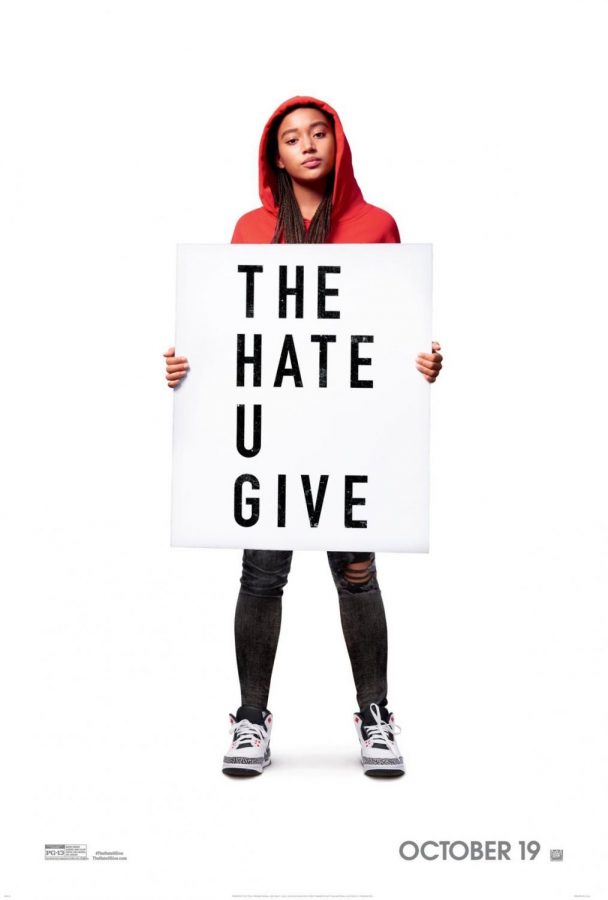The Hate U Give: Tackling Racism in Young Adult Fiction
Angie Thomas’ The Hate U Give was published in Feb. 2017. Its movie adaptation was later released to the public worldwide on Oct. 19. Photo courtesy of imdb.com
October 25, 2018
America has a racism problem. This isn’t something new, or revolutionary, or even distinctly refutable. We’ve held onto this idea that skin color determines something fundamental about their person, whether that be good or bad, since this country even began.
I certainly am not one to have firsthand experience with these issues, or to pretend like I can understand someone who is a victim of racism. As a white male, I’m so far flung from these situations that haunt our society that it’s almost ironic that I’m even writing this right now. However, educating yourself about such topics is often the best-case scenario, and I’m hoping that the viewpoint I provide here will help others with their own education about race issues in America.
In recent years, outrage has sparked and movements have sprung following countless incidents that have just now begun to appear on the news. The horrible deaths of Trayvon Martin, Michael Brown, and the countless others like them has begun movements such as Black Lives Matter. In that changing political climate arose The Hate U Give, written by Angie Thomas and published in Feb. 2017, earning critical acclaim worldwide after weeks and weeks of hype, build-up, and anticipation.
The Hate U Give centers on Starr Amara, an African-American girl living in Garden Heights, the gang-ridden “south-side” of town, and her struggle as a witness of a white cop shooting a young unarmed black man, Khalil, who also happened to be one of her close friends. The story follows the aftermath of the crime, and also Starr’s complicated and intertangled personal life as she switches between her predominantly white, preppy and privileged private school and the poorer mostly black neighborhood she lives in. It’s a stark, brutally honest, but much needed portrayal of black lives in America.
Following the instant success of the novel’s release and New York Times Bestseller status, which it still holds to this day, the movie was instantly grabbed for film adaptation, which was just recently released worldwide on Oct. 19 following a select release on Oct. 5th to a positive reception and box office recording.
The Hate U Give deals with a tough and difficult topic to tackle, especially in the form of a young adult novel. Police brutality is constantly on the news, but the news-like format gives it a far-off feeling that makes the horror seem distant. Here, we are directly in the shoes of someone who has witnessed the shooting of one of her own best friends right before her very eyes. The emotional impact of the incident and the following events is something we directly experience as Starr and not as yet another person watching the news. The first person narrative gives us a first hand account and look into the everyday life and pain American POCs face on the daily. Even beyond the topic of police brutality, The Hate U Give analyzes the dynamic of poorer black neighborhoods, of white ignorance and privilege with Starr’s enrollment in the private Williamson Prep, of white boyfriends and other difficult racial issues. Despite the complexity of its subject matter, this is all handled in a well-crafted story format that’s intensely likeable and readable.
What makes the story of the book (or the movie, if you’re that kid) so compelling is the complex cast of characters Thomas has created. Each and every one of the personalities and people we see are memorable and vibrantly crafted. There’s Nana, a stubborn grouch who constantly made me laugh, Starr’s mom, who’s life lessons could almost make you tear up a little bit, and Sekani, the most annoying and yet adorable little brother of all time. Every character here could practically step off the page and into real life because of simply how good Thomas is at her characterization. As readers or as viewers, the experience of watching Starr’s life is enjoyable and painful because of how enduringly likeable each character we meet is, and how we get up and fall down with their own struggles throughout the plot. This central core of a tight-knit cast of characters is what makes the book so endearing and masterful, and the topics at hand are heightened in both the movie and book with Thomas’ powerful storytelling.
When it comes to the movie adaptation, it’s clear that very little cuts were made between the novel and the final product, besides the obvious omissions that come with the time crunching of a film. Without giving too many spoilers, there’s a shocking twist to the ending that comes as a welcome surprise for many readers of the original novel. Overall, though, changes between the text and script are almost nonexistent, something extremely welcome especially after disasters such as the Percy Jackson adaptations. The subject matter is treated with just as much care on the big screen as it is in the book, and the experience is almost just as compelling.
If you haven’t read or seen The Hate U Give, I highly recommend it, especially if you want to educate yourself more about the race issues plaguing our society today. Of course, I would read the book first, but if you’re not one of those people, the movie offers just as powerful of an experience from start to finish. Thought-provoking, haunting, and packed with beautifully crafted characters, The Hate U Give is a cultural phenomenon that you really don’t want to be missing out on.






